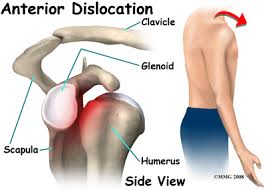Anterior Shoulder Dislocation Injury
Shoulder dislocation is a common injury in contact sport and is painful, requiring prompt treatment. Dislocation occurs when the arm is in an elevated position, outstretched and takes an impact to the front or back of the shoulder.
Shoulder dislocation is a common injury in contact sport and is painful, requiring prompt treatment. Dislocation occurs when the arm is in an elevated position, outstretched and takes an impact to the front or back of the shoulder. Usually the shoulder will also be forced into an “externally rotated” position as demonstrated by the diagram on the right. If the force of the impact is strong enough, the head of humerus (the ball) will be forced out of the front of the glenoid (the socket).
During a shoulder dislocation, various damage occurs
- The “glenohumeral ligaments” are responsible for maintaining the ball in the socket and these ligaments which sit at the front of the joint will be torn and resulting in laxity.
- The cartilage that sits around the socket – the labrum – is often torn.
- Fracture to the actual socket.
- There are some other structures that typically will be irritated or damaged our skilled physiotherapist will assess what that damage may be.
Advanced Physio Treatment
Usual initial management of a dislocation is conservative, focussing on returning strength and movement to the shoulder. Conservative management of a dislocated shoulder initially involves a period of immobilisation to allow the joint capsule to stiffen and repair.
Following this, our physiotherapist will supervise a customised graded-strengthening and stability program to return the shoulder to maximum movement and strength. A well designed program will allow the maximum amount of healing to take place. Surgical Repair For acute dislocations, surgical techniques are necessary in some circumstances.
We can discuss this option with your general practitioner if it is necessary. Injury Recurrence After a shoulder dislocation, the joint will become much more “loose” and making subsequent dislocations much easier.
The risks are increased for patients returning to contact sports. The risk of having another dislocation, is as high as 85-95% in contact sports such as rugby. The risk of dislocation after surgical repair and rehabilitation is much lower around 10-15%.

